Changi Prison
Changi Prison Complex. often known as simply Changi Prison, is a prison located in Changi in the eastern part of Singapore.
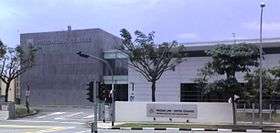 The Prison Link Centre of the Changi Prison Complex in Changi, Singapore. | |
.svg.png) | |
| Coordinates | 1°21′25.47″N 103°58′25.11″E |
|---|---|
| Status | Operational |
| Security class | Maximum |
| Capacity | 11,000[1] |
| Opened | 1936 (84 years ago) |
| Managed by | Singapore Prison Service |
History
First prison and POW camp

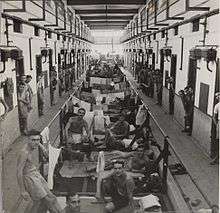
Changi Prison was constructed by the British administration of the Straits Settlements as a civilian prison in 1936. When it was officially operational in June the following year, it was declared as one of, if not the best, prisons throughout the vast British Empire. The design of the prison was based off a "T"-shaped structure, with two cell-block wings stretching out from a central main block (for administration areas and warden-offices), to allow for quick and easy access to either cell-block wing for the wardens whenever necessary (from up above, the prison buildings formed the shape of the top of a telegram/telephone pole). Changi Prison also boasted the use of an advanced and extensive alarm system and had electrical lighting in its cells along with flush-toilets in each. The prison had a holding capacity of 600.
During World War II, following the Fall of Singapore in February 1942, the Japanese military detained about 3,000 civilians in Changi Prison, which was built to house only one-fifth of that number. The Japanese used the British Army's Selarang Barracks, near the prison, as a prisoner of war camp, holding some 50,000 Allied soldiers, predominantly British and Australian, and from 1943, Dutch civilians brought over by the Japanese from the islands in the Dutch East Indies (now Indonesia).[2] POWs were in fact rarely, if ever, held in the civilian prison at Changi. Nevertheless, in the UK, Australia, The Netherlands and elsewhere, the name "Changi" became synonymous with the infamous POW camp nearby, since most of the Japanese prisons were in the Changi area. Around 500 detainees were women who had been separated with their children and marched to the cramped prison camp from their homes. These women and also girls sewed quilts for the prison hospital, daringly embroidering their own secret symbols and stories into the squares, including forget-me-nots, butterflies, angels, scenery of trees and sheep, other symbolic flowers and even a domestic sitting room, ships, birds and a map of Scotland, and one of Australia. They risked severe punishments by sewing depicting their prison environment and adding dozens, or even over 400 names, in one case onto the cloths. One depicted the Changi Stroll, the forced march of the captive women and children over 9 miles to the prison under the occupation by the Japanese on 8 March 1942, coincidentally now International Women's Day commemorating women and the defiance of the suffragettes. Surviving examples of the prison handiwork are in the archives of the British Red Cross, Imperial War Museum, London or held at the Australian War Memorial.[3] About 850 POWs died during their internment in Changi during the Japanese occupation of Singapore,[4] a relatively low rate compared to the overall death rate of 27% for POWs in Japanese camps.[5] However, many more prisoners died after being transferred from Changi to various labour camps outside Singapore, including those on the Burma Railway and at Sandakan airfield.
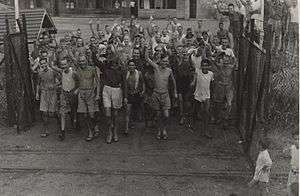
Allied POWs, mainly Australians, built a chapel at the prison in 1944 using simple tools and found materials. Stanley Warren of the 15th Regiment, Royal Regiment of Artillery painted a series of murals at the chapel. Another British POW, Sgt. Harry Stodgen, built a Christian cross out of a used artillery shell. After the war, the chapel was dismantled and shipped to Australia, while the cross was sent to the UK. The chapel was reconstructed in 1988, and is now located at the Royal Military College, Duntroon, Canberra. The prisoners of war also established an education program nicknamed the Changi University.[6]
After the war, the prison was used by the returning British to hold former Japanese staff officers, Kempeitai, police and guards from concentration camps. Executions were conducted in the inner yard where three gallows were erected. British soldiers were stationed there as prison guards. On 17 October 1945, all 260 German seamen of former U-Boats based in Southeast Asia (in joint operations with the Imperial Japanese Navy during the war) were moved from Pasir Panjang to the prison. On 26 June 1946, all German soldiers and a few civilians were notified they would be shipped back to England on a passenger liner, the Empress of Australia, before their eventual return to Germany.[7]:245–252
Kempeitai
The prison also contained the headquarters of the Kempeitai, the Japanese military police. The Kempeitai tortured and (rarely) executed prisoners there, who they suspected were spies. Most were civilians, although a small number were Allied POWs.
Changi Chapel and Museum
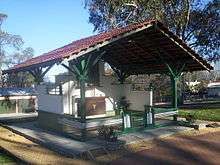
The original open air chapel, built by the POWs in 1944, was later relocated to Duntroon, Canberra.
In 1988, Singapore built a replica chapel, next to the Changi Prison. The project included a museum. When Changi Prison was expanded in 2001, the chapel and museum were relocated to a new site 1 kilometre (0.62 mi) away, officially reopening on 15 February 2001.
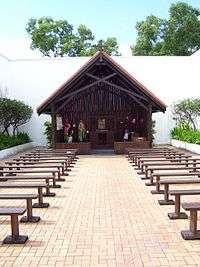
Demolition
In 2000, the old prison was demolished and its inmates were relocated to a new consolidated prison complex in a neighbouring site, just slightly behind the original prison's plot. In view of its historical significance, the Preservation of Monuments Board worked with the Singapore Prison Service and the Urban Redevelopment Authority to allow the old prison's iconic front walls, front gates and two guard-towers at either end of the wall to be preserved. In 2016, the historical remnants of the old prison – the entrance gate, wall and turrets – was gazetted as the 72nd National Monument of Singapore.[8][9] Although technically a historical site, access to it is not granted as it sits in a restricted area (at the front gate of the current prison) and visitors are only allowed to go in pre-registered/authorised groups. At the most, it is possible to see the preserved remnants of the colonial prison behind a tall wire fence, albeit it being a privacy-screen with visibility almost entirely blocked unless one peeps through the small gaps in the fencing.
In 1994, Changi Women's Prison and Drug Rehabilitation Centre was opened.
Current prison
Presently, the new Changi Prison houses the most serious criminal offenders in the country, including criminal offenders who are serving long sentences and those who have been sentenced to death. It serves as the detention site for death row inmates at Changi, before they are executed by hanging, traditionally on a Friday morning.
Changi Prison is also one of the main places (though not the only one) where judicial corporal punishment by caning is carried out. Caning sessions at Changi are held twice per week. A former employee of the prison has been quoted in 1995 as saying: "They are flogging more and more these days. Before they were doing maybe 60 on Tuesdays and Fridays, now they're doing a hundred".[10]
Notable detainees
Prisoners of war
- Sir Norman Alexander Professor of Physics, Raffles College, Singapore, Vice-Chancellor, Ahmadu Bello University, Nigeria. Helped build a salt evaporation plant at Changi and a small industrial plant that fermented surgical spirit and other products for prison hospital.
- Sir Harold Atcherley, businessman, public figure and arts administrator.
- Geoffrey Bingham, AM, MM, (6 January 1919 – 3 June 2009), who returned to Australia and wrote several books reflecting on his experiences, including his conversion to Christian faith in The Story of the Rice Cakes,[11] Angel Wings,[12] and Tall Grow the Tallow Woods.[13]
- Freddy Bloom, journalist and campaigner for deaf children[14]
- Russell Braddon, (25 January 1921 – 20 March 1995), Australian writer, who wrote "The Naked Island" about his POW experience.
- Sheila Bruhn[15] (née Allan), who wrote about her experiences in Diary of a Girl in Changi.
- Sir John Carrick (Australian politician), AC, KCMG (4 September 1918 – 18 May 2018). The impact of his experiences on his political thinking is described in his biography, "Carrick: Principles, Politics, and Policy," written by Graeme Starr.
- Anthony Chenevix-Trench (10 May 1919 – 21 June 1979), Headmaster of Eton College, 1964–1970.
- James Clavell is one of the most famous survivors; he wrote about his experiences in the book King Rat.
- Eugene Ernest Colman, chess master.
- John Coast British, (30 October 1916 – 1989), writer and music promoter. He wrote one of the earliest and well-known POW memoirs of Changi The Railroad of Death, (1946). Coast admitted that he and his fellow officers regularly stole coconuts during the night to alleviate their hunger. Other works of Coast include Dancers of Bali (1953), and Dancing Out of Bali (1954).
- Hugh Edward de Wardener, British, CBE, MBE, (8 October 1915 – 29 September 2013), physician and professor of medicine at Charing Cross Hospital. He was a member of the Royal Army Medical Corps. He operated a Cholera Ward at the prison hospital. He also treated British soldiers who were forced to build the Burma Railway, as fictionalised in the film The Bridge on the River Kwai (1957). He was a gifted renal research physician having made many breakthroughs in that area. Although he attained the advanced age of nearly 98, he suffered from peripheral neuropathy, a legacy of Changi, in his last months. He died in the De Wardener Ward, the intensive care renal unit at Hammersmith Hospital, Acton, London, England.[16]
- Noel Duckworth, Chaplain, Churchill College, Cambridge.
- John Cade, Australian psychiatrist who pioneered the use of lithium in bipolar disorder.
- Lieutenant Colonel Sir Ernest Edward "Weary" Dunlop, AC, CMG, OBE (12 July 1907 – 2 July 1993) was an Australian surgeon who was renowned for his leadership
- Carl Alexander Gibson-Hill, medical doctor and Director of the Raffles Museum.
- John Hayter, Anglican priest who later wrote of his experiences in Priest in Prison.[17]
- Percy Herbert, actor. Noted for roles in Bridge on the River Kwai and Mutiny on the Bounty, The Guns of Navarone and Tobruk.( 1920-1992)[18]
- Graham Hough, Professor of English, University of Cambridge, 1966–75.[19]
- Ezekiel Saleh Manasseh (died 1944), British rice and opium merchant, died in Changi Prison[20]
- Sir Percy McElwaine, the Chief Justice of the Straits Settlement.
- Jim Milner AM (1933–1937), Former chairman Washington H. Soul Pattinson and former President NRMA.[21]
- Sir Alexander Oppenheim, mathematician.In 1984, he published "The prisoner's walk: an exercise in number theory", based in part of his experiences at Changi.
- Lieutenant-General Arthur Ernest Percival, commander of Allied forces in Singapore, following his surrender to the Japanese; he was moved to a camp in China in late 1942.
- Sydney Piddington, postwar Australian mentalist entertainer with wife Leslie, "The Piddingtons" ABC and BBC radio and stage mindreading team, who developed his verbal code in Changi.
- Rohan Deakin Rivett, Australian, writer (16 January 1917 – 5 October 1977) War correspondent and journalist with British Malaya Broadcasting Corporation in Singapore. Formerly a soldier in the Australian Imperial Force. Although the British surrendered the island on 15 February 1942, he was not captured until 8 March, in Java, after harrowing journeys by sea and land. His harrowing experiences are vividly chronicled in Behind Bamboo (1946). The book, 392 pages long, was written in October–November 1945 while its author was recovering from the rigours of captivity; reprinted eight times, it sold more than 100,000 copies.[22]
- Tjalie Robinson, (1911–1974), Dutch Indo-European (Eurasian) author, activist, journalist.
- Ronald Searle, cartoonist.
- Robert Skene, ten goal polo player.
- The Reverend James Donald (Donald) Smith, British 18th Division, author of And All The Trumpets, a history of his time as a POW in Changi Prison and building the Burma Road.
- Colonel Julian Taylor FRCS, surgeon.
- Ernest Tipson, linguist.
- Sir Michael Turner, Chief Manager of the Hong Kong and Shanghai Bank (1953–1962)
- Arthur Varley, Australian Army officer & diarist
- Leo Vroman, Dutch poet.
- Stanley Warren, artist and art teacher; murals produced during his incarceration remain at the prison.
- Ian Watt (9 March 1917 – 13 December 1999), literary critic, literary historian and professor of English at Stanford University.
- Leonard Wilson, Bishop of Singapore, and later Bishop of Birmingham.
- Sir Michael Woodruff, surgeon and scientist.
Convicted criminals incarcerated after conversion from a wartime prisoner camp
- Hiroshi Abe, Japanese war criminal
- Nick Leeson, former derivatives broker convicted of rogue trading in the collapse of Barings Bank
- Janatin and Harun Thohir, executed in 1968 for the MacDonald House bombing
Others
- Van Tuong Nguyen, a Vietnamese-Australian executed in 2005 for drug trafficking[23]
- Peter Lloyd, an Australian journalist with the Australian Broadcasting Corporation arrested in July 2008 for drug trafficking and possession[24]
In popular culture
- King Rat (1962 novel), by James Clavell
- King Rat (1965 film), based on the novel
- Changi: The fortunes of a fictional group of Australian POWs were dramatised in this television miniseries, screened by Australian Broadcasting Corporation in 2001.
See also
- Changi Murals
- Double Tenth incident
- John Mennie – prisoner who drew life in the camps and the Selarang Square Squeeze.
- Kempeitai East District Branch
- Selarang Barracks Incident
References
- "More capacity at Changi Prison". 21 January 2010.
- "Changi Heritage: Changi and the War". Habitatnews.nus.edu.sg. Retrieved 3 December 2016.
- Hunter, Clare (2019). Threads of life : a history of the world through the eye of a needle. London: Sceptre (Hodder & Stoughton). pp. 50–58. ISBN 9781473687912. OCLC 1079199690.
- "Journal of the Australian War Memorial | Australian War Memorial". Awm.gov.au. Retrieved 3 December 2016.
- "Military History Online". Military History Online. Retrieved 3 December 2016.
- "Backgrounder: Memorial unveils one-of-a-kind Changi manuscript". Australian War Memorial. Retrieved 7 January 2017.
- Giese, O., 1994, Shooting the war: The memoir and photographs of a U-boat officer in World War II, Annapolis: United States Naval Institute, ISBN 1557503079
- "NHB gazettes Changi Prison entrance gate, wall, turrets as National Monument". Channel NewsAsia. Retrieved 3 December 2016.
- "Changi Prison Gate Wall and Turrets". Roots. National Heritage Board. Retrieved 10 September 2019.
- "Eye of a Tiger", The Guardian, London, 20 May 1995
- "The story of the Rice Cakes". Archived from the original on 21 February 2011.
- "Angel Wings". Archived from the original on 16 February 2011.
- "Tall Grow the Tallow Woods". Archived from the original on 21 February 2011.
- Frankel, William (22 July 2000). "Freddy Bloom". The Guardian. London.
- "Sheila Bruhn | Australians at War Film Archive". australiansatwarfilmarchive.unsw.edu.au.
- Richmond, Caroline (29 October 2013). "News Science Medical research Hugh de Wardener obituary". The Guardian. Retrieved 30 December 2013.
- John Hayter Priest in Prison Tynron Press 1991 ISBN 1-85646-051-7
- Dr Katrina Wood daughter
- Frank Kermode, 'Scholar-poet of Romantics', The Guardian, 10 September 1990.
- "Portrait of Mr. Ezekiel Manasseh, before 1945 – BookSG – National Library Board, Singapore". Eresources.nlb.gov.sg. Retrieved 3 December 2016.
- Who's Who in Australia (Crown Content Melb, 2007) pp 1444: Millner, James Sinclair (1919–2007)
- K. S. Inglis. "Biography – Rohan Deakin Rivett – Australian Dictionary of Biography". Adb.anu.edu.au. Retrieved 3 December 2016.
- Butcher, Steve; Levett, Connie (3 December 2005). "Death-row mates sing for Nguyen at the end". The Age. Retrieved 2 October 2015.
- "ABC journalist faces 20 years' jail on trafficking charge". The Sydney Morning Herald. 18 July 2008. Retrieved 2 October 2015.
External links
- Singapore Prison Service| Changi Prison
- Changi drawings (1942–1945) / John Noel Douglas Harrison (1911–1980)
- Fong, Tanya. "New Changi Prison goes high-tech." The Straits Times: 16 August 2004.
- Choo, Johnson. "New technology at Changi Prison Complex allows focus on rehabilitation." Channel News Asia: 16 August 2004.
- List of U.S. internees at Changi Prison
- Voices of civilian internment: WWII Singapore, a digitised collection in Cambridge Digital Library, contains official administration documents and first hand accounts of life from the civilians interned at Changi/Sime Road